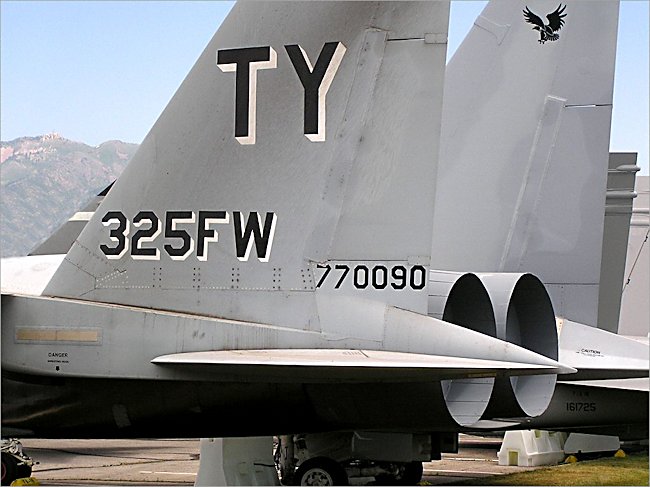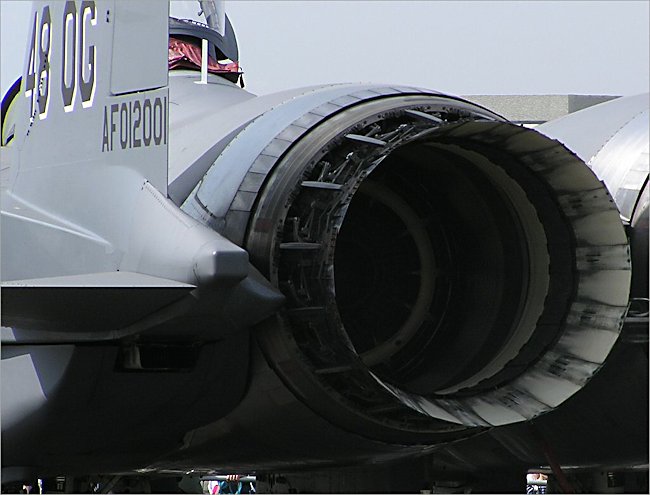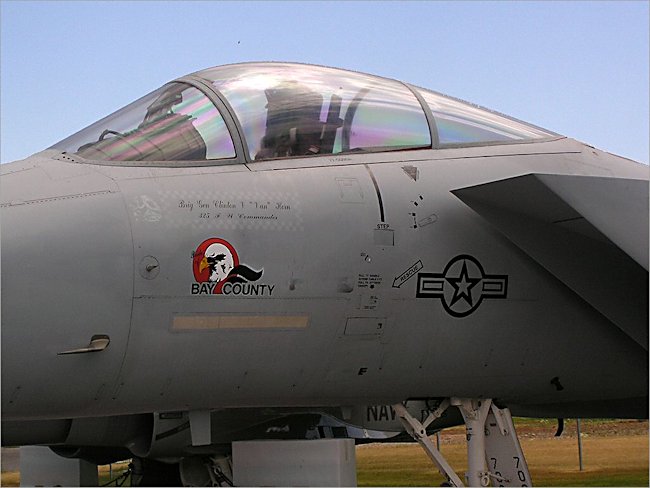McDonnell Douglas F-15 Eagle
The US Air force wanted a new all weather powerful agile air superiority fighter that could overcome any current or projected Soviet threat. It was required to have an unequalled combination of firepower, performance and avionics. The skills and research of NASA were used in this aircrafts development. McDonnell Douglas used this knowledge and improved on it. Their resulting prototype won the aviation industry tendering process in December 1963. The Eagle first flew in July 1972, and entered service in 1976. The F-15 is expected to be in service with the U.S. Air Force until 2025 or when replaced by the Lockheed Martin F-22 Raptor and Lockheed Martin F-35 Lightning II stealth multi role fighters as they come off the production line.
The radars on the F15 Eagle allow pilots to see targets 100 miles away. A TEWS Tactical Electronic Warfare System lets the aircrew know if the contact is a threat. The F-15's HOTAS Hands on Throttle and Stick system, allows the Pilot to select, track and shoot the adversary via the HUD. The F-15 Eagle's HUD head-up display projects on the necessary all essential flight information weapons systems on to the windscreen. This has the advantage that the pilot does not have to look down at cockpit instruments when in combat. The F-15 has two Pratt & Whitney F100-PW-100 afterburning turbofan engines of 23,904/14,780 pounds thrust each.

The F-15 can carry lots of different missiles like the AIM-9L/M Sidewinder, AIM-9X or AIM-120 missiles on two pylons under the wings, AIM-7F/M Sparrow missiles or AIM-120 Advanced Medium Range Air-to-Air Missiles on its lower fuselage corners and it has an internal 20mm Gatling gun with 940 rounds of ammunition in its right wing root. Its electronic warfare system provides automatic countermeasures and threat warnings. The "friend or foe" ID system tells the pilot if a boogie aircraft seen on radar is friendly. It also informs other friendly ground and air units that the F-15 is a friendly aircraft. The F-15 Eagle has been in service for over 20 years and the Multi-stage Improvement Program (MSIP) was started in the 1990s to make sure all the fleet are upgraded in avionics and weapon systems to meet the ever changing needs of modern air to air combat.
The F-15 Eagle was designed as an air superiority fighter with no ground attack role, but this changed in the 1990s with operation desert storm. F-15E Strike Eagle was equipped with an array of new avionics and electronics systems for ground attack deployment. Unlike normal F-15 Eagles the Strike Eagle had two crew members, a pilot and a weapon systems officer. It had to have the capability to fight its way to the target over long ranges, destroy enemy ground positions, and fight its way back to base day at low altitude, day or night, and in bad weather.

The F-15 has a "look-down/shoot-down" radar that can distinguish low-flying moving targets from ground clutter. The Eagle can be armed with combinations of four different air-to-air weapons: AIM-7F/M Sparrow missiles or AIM-120 AMRAAM advanced medium range air-to-air missiles on its lower fuselage corners, AIM-9L/M Sidewinder or AIM-120 missiles on two pylons under the wings, and an internal M61A1 20 mm Gatling gun in the right wing root.
The first F-15 Eagle combat victory was scored by IAF ace Moshe Melnik in 1979. In 1979 - 81, during Israeli raids against Palestinian factions based in Lebanon, an Israeli Air Force F-15As downed 13 Syrian Russian built MiG-21 "Fishbeds" and two Syrian MiG-25 "Foxbats",

The USAF deployed F-15C, D and E models to the Persian Gulf in 1991 in support of Operation Desert Storm where they accounted for 36 of the 39 Air Force air-to-air victories mostly by air to air missile fire. After the ground defences and the Iraqi air force had been destroyed or fled to Iran the F-15 Eagle was used for ground attack.

The F-15's maneuverability is derived from low wing loading weight to wing area ratio with a high thrust-to-weight ratio enabling the aircraft to turn tightly without losing airspeed, but the F15 Eagle was criticism by some in the Pentagon as still being too large to be a dedicated air superiority jet dogfighter, and too expensive to procure in large numbers. This led to the Lightweight Fighter (LWF) program, which led to the USAF F-16 Fighting Falcon and the middle-weight Navy F/A-18 Hornet and later Super Hornet.